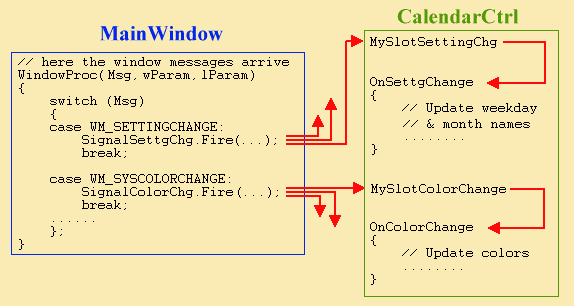Qt Signal And Slots Callback
In this chapter we will add some functionality to the window and we will learn how to obtain the values from the different widgets.
About Qt Signals and Slots
Qt (and therefore PySide/PyQt) has built-in signals and slots to control the most common functionalities of widgets. Signals are messages that are emitted by a widget when a certain event or action ocurs (a button was pressed, for example). Slots receive inputs from signals, and are able to perform common actions such as update a value or enable a widget. Signals and slots can be connected together as an easy way of achieving complex behaviors from common wiget interactions.
Signals and Slots In Qt, we have an alternative to the callback technique: We use signals and slots. A signal is emitted when a particular event occurs. Qt's widgets have many predefined signals, but we can always subclass widgets to add our own signals to them. Callback.onWiFiDeviceDiscovered(pDevInfo, x); You would emit a signal: emit onWiFiDeviceDiscovered(pDevInfo, x); And you would use QObject::connect to connect these signals to your actual receivers (slots) on the other end. Be aware that emitting a signal is more expensive than calling a virtual function. One benefit of Qt's solution is that the sender is not dependent on the listener, it's just firing off the signal. In a callback mechanism the sender usually needs to know which listeners to notify. Another benefit, in contrast to many other callback implementations, is that the signals and slots functions are type safe. Please, tell me how is right to call the implementation of a slot. Void slotAnsverFromRunnableClass(uint index) from class Runnable I tried. QMetaObject::invokeMethod(mpcontroller,'slotAnsverFromRunnableClass',Qt::AutoConnection,QARG(uint,index));, but it gave no results and no output to the console QtCreator about the mistake too.
More info on signals and slot here at ZetCode.
Adding callbacks
The first action we want to be performed is to disable the cornerSpinBox when the cornerCheckBox is unchecked. To achieve this, we will define a callback function insde the class PCBOutlineCreator:
And we will connect the signal emitted when the state of the CheckBox changes to this callback:
Now, we can write the code to be executed inside the callback:

If we run the code, we can see that initially the cornersSpinBox is still enabled. As the initial state was unchecked, the state has not changed on reset and the signal was not sent. In order for the code to run as expected we have to either modify our UI file to make the checkbox enabled by default, modify the UI file to make the spinbox disabled by default, or perform either of these actions programatically using this sentence:
Qt Signal Slot Callback
Using Qt Signals and Slots

Previously we added a callback function to disable the cornerSpinBox if it is unchecked. We can achieve the same result easily by connecting the corresponding signal and slot:
In this case, as stateChanged signal returns an int and setEnabled expects a bool, a lambda function was used to convert the value.
Extracting values from the widgets
In order to create the outline for our PCB, we need the dimensions specified by the user in the different widgets. For that pursose, we will add a callback to the save button that prints on the stdout the different values extracted from the widgets. first, we connect the signal to the callback:
And then we add the callback funtion. Inside this function, we request the values of the different widgets and we print them on the stdout:
Qt Signal Slots Vs Callbacks
When we run the code, and press the save button we get the following message on the stdout: